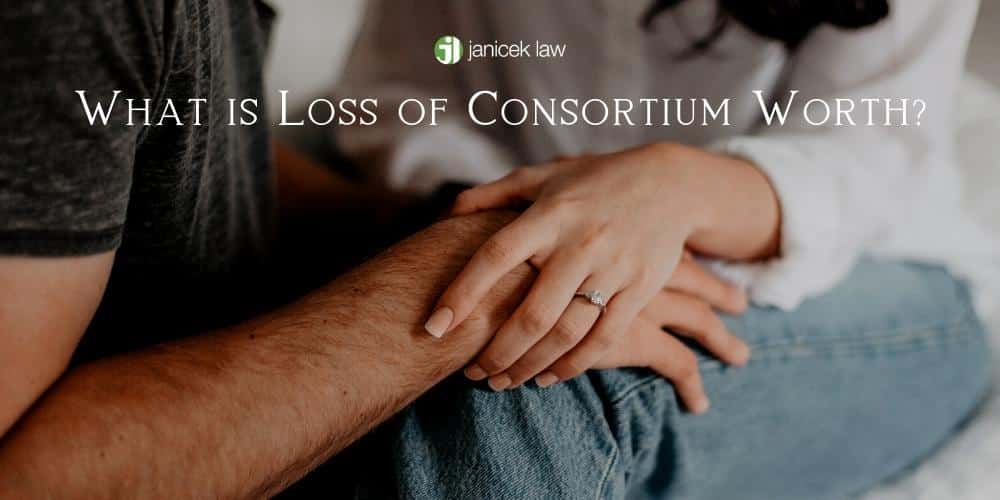Loss of consortium is a legal term used to describe the impact that catastrophic injuries or wrongful death have on a marriage or domestic partnership. Although this negative and permanent impact can’t be measured monetarily, a fair amount of financial compensation can help you slowly rebuild your life. If you’re the uninjured spouse in this situation, you may be wondering: what is loss of consortium worth? Below, San Antonio personal injury lawyers at Janicek Law break down the specifics of loss of consortium claims: what they are, how to prove them, how to calculate financial compensation, and so much more.
If someone else’s negligence caused your spouse’s injuries or death, you need strong legal representation on your side. The experienced legal team at Janicek Law can analyze the details of your case and help you figure out the best course of action. Call 210-366-4949 to schedule a free consultation today.
What is Loss of Consortium?
Loss of consortium is a type of personal injury case filed by an uninjured spouse or close loved one of a wrongfully injured person. A loss of consortium claim can also be filed when a negligent party wrongfully kills someone’s spouse or loved one.
Loss of consortium basically means that some part of the marital relationship has been permanently lost or changed due to the victim’s injuries, mental state, or death. For example, a spouse’s injury or death may prevent sexual relations, pregnancy, moral support, companionship, affection, or even normal conversation from occurring in the relationship ever again.
These losses fall under the category of non economic damages – AKA intangible losses – in a regular personal injury or wrongful death claim. However, you can file a whole separate claim just for loss of consortium if you and your legal team feel that is the right thing to do.
Traumatic Events and Accidents That Can Lead to a Loss of Consortium Claim
A variety of traumatic events and accidents can cause severe injuries, and therefore, loss of consortium, including:
- Motor vehicle accidents such as car accidents, 18 wheeler accidents, pedestrian accidents, bicycle accidents, and motorcycle accidents
- Medical malpractice cases such as medication errors, surgical errors, birth injuries, diagnostic errors, etc.
- Sexual abuse
- Drug injuries
- Product liability injuries
- Slip and fall injuries
- Wrongful death
If your loved one has suffered a major permanent injury from the aforementioned events, you may have grounds to file a loss of consortium claim. A San Antonio personal injury lawyer at Janicek Law can help you determine if you have a strong case.
Types of Injuries That Can Lead to Loss of Consortium
Catastrophic injuries generally lead to loss of consortium. Examples of injuries that could warrant loss of consortium damages are listed below.
- Traumatic brain injuries such as a subdural hematoma
- Post concussive syndrome
- Spinal cord injuries
- Partial or complete paralysis
- Nerve damage
- Vision or hearing loss
- Burn injuries
- Amputations
- Chronic pain
- Organ damage or dysfunction
- Sexual dysfunction
- Any incapacitating injury that results in permanent disfigurement or disability
Who Can File a Loss of Consortium Claim?
Non injured spouses/partners and close family members (such as parents and children) are the only ones who can file a loss of consortium claim. In the past, only spouses could file and claim damages from a loss of consortium case. Now, domestic partners can file a claim and potentially recover damages too.
A family member – such as a parent or a child – can also file a loss of consortium claim in some states. They would basically claim that the victim’s injury prevents them from having the same love, moral support, care, financial support, etc. as before their accident.
How to Prove Loss of Consortium
Proving loss of consortium can be really challenging and even embarrassing for some people. Providing proof that the victim’s mental state, injury, or death drastically changed the marital relationship requires legal teams and juries to ask the uninjured spouse about intimate information. For example, an experienced attorney may ask about (and gather evidence to support) how the spouse’s injuries impacted the following factors:
- Marital relations on a weekly/monthly basis
- Fertility and pregnancy
- Living and sleeping arrangements
- Emotional support
- Life expectancy of the injured spouse
- General love, contentment, and stability in a relationship
- Household services such as cooking and cleaning
- Childcare services
- Financial support
Of course, the first step in proving loss of consortium is proving that the plaintiff is in a lawful marriage or a domestic partnership with his or her spouse. This can be easily proven through an official certificate of marriage. Or, in the case of a domestic partnership, this can be proven through shared finances, witness statements, or even proof of a shared living space.
Expert witnesses, medical records, pictures, videos, criminal history (if any), and personal journal entries may be able to prove the other aspects of a loss of consortium claim.
What to Consider Before Filing a Loss of Consortium Claim
Before you file a loss of consortium claim, it’s important to remember that almost every aspect of your relationship is going to be put in the legal spotlight. That means that everyone is probably going to learn about and analyze the good, the bad, and the ugly.
If you and your spouse have had major issues over the years (such as temporary separations, infidelity, physical/psychological/verbal/financial abuse), this could greatly impact the amount of recoverable financial compensation in a loss of consortium claim.

Important Elements of a Loss of Consortium Claim
Strong loss of consortium claims require sufficient proof of the following elements:
- A valid marriage or domestic partnership exists.
- A person’s negligence directly caused the spouse’s injury.
- As a result, the uninjured spouse suffered some type of loss of consortium.
- The spouse’s injuries directly caused the loss of consortium.
These elements may sound easy to prove, but in some cases, it’s very difficult due to lack of substantial evidence. That’s why it’s important to hire an experienced personal injury lawyer at Janicek Law. We have what it takes to gather enough evidence to prove that loss of consortium certainly occurred as a result of an accident.
Recoverable Damages for Loss of Consortium
As previously stated, loss of consortium falls under the non economic damages category in a personal injury case. If you were to file a separate claim just for loss of consortium, you could recover damages for things like:
- Loss of sexual relations
- Loss of fertility and/or the ability to have a pregnancy
- Pain and suffering
- Loss of companionship
- Emotional distress
- Loss of reputation
- Embarrassment and/or humiliation
- Permanent disfigurement and disability
- Inconvenience
How to Calculate Loss of Consortium Damages
Now back to the question at hand: what is loss of consortium worth?
Calculating damages for loss of consortium is difficult because this loss cannot be measured monetarily like medical bills, for example. Many times in personal injury claims, non economic damages are calculated through a multiplier. So a legal team or jury will add up the monetary damages – such as medical bills, lost wages, etc. – and multiply that total with a number from 1 through 5. The multiplier will generally be determined by the severity and duration of the pain and suffering, with 1 being the least severe and 5 being the most severe.
So in a loss of consortium claim, the multiplier may be on the more severe side if the non injured spouse has to become a full-time caretaker for the injured spouse. In a situation like this, the injured spouse would no longer be able to work, perform household duties, take care of children, engage in intimate relations, perform basic self-care, and more.
Once the economic damages have been multiplied by the most accurate number, you would get your average loss of consortium case worth. This total could be hundreds of thousands of dollars.
Does Texas Have a Cap on Non-Economic Damages?
No, Texas doesn’t have a cap on non-economic damages in general personal injury cases. However, Texas does place a cap on non-economic damages in medical malpractice cases.

Call San Antonio Personal Injury Lawyers at Janicek Law Today
If personal injuries have negatively affected your marriage or domestic partnership, you may have grounds to file a loss of consortium claim against the responsible party. The legal team at Janicek Law wholeheartedly understands that even though permanent changes to a relationship can’t be measured monetarily, they are often just as devastating as other economic losses. We have what it takes to take on your case and help you recover fair compensation. Call 210-366-4949 to schedule a free consultation today.

